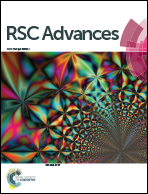A study on the electrochemical behavior of hydroquinone at a nanometer cobalt/l-glutamate-modified electrode
Abstract
A new electrochemical sensor for hydroquinone (HQ) was prepared. The electrochemical sensor was modified by electrodeposition and electrochemical polymerization to modify nanometer cobalt (nano-Co) and poly-L-glutamic acid (poly-L-glu) on the surface of a glassy carbon electrode (GCE). Then, the electrochemical behavior of hydroquinone on the electrochemical sensor was investigated by cyclic voltammetry (CV). The experimental conditions were optimized from the aspects of electrolyte type, concentration, acidity, enrichment time and scanning speed. The experimental results showed that under optimized conditions the oxidation peak current has a good linear relationship with the concentration of hydroquinone in the range of 3.85 × 10−6 to 1.30 × 10−3 mol L−1 (R2 = 0.9998). Moreover, there was a low detection limit of 4.97 × 10−7 mol L−1. When the sensor was used for the analysis of hydroquinone in water samples, the recoveries with satisfactory results were in the range of 97.2–102.6%.



 Please wait while we load your content...
Please wait while we load your content...